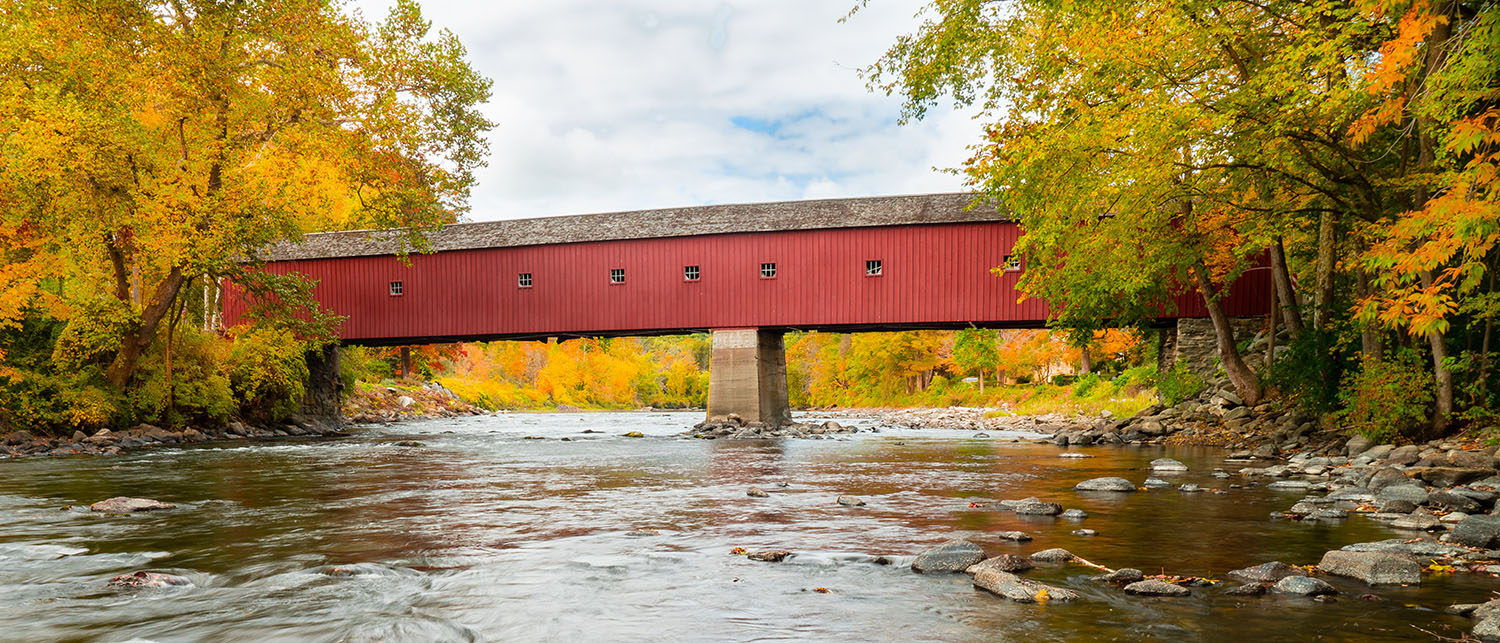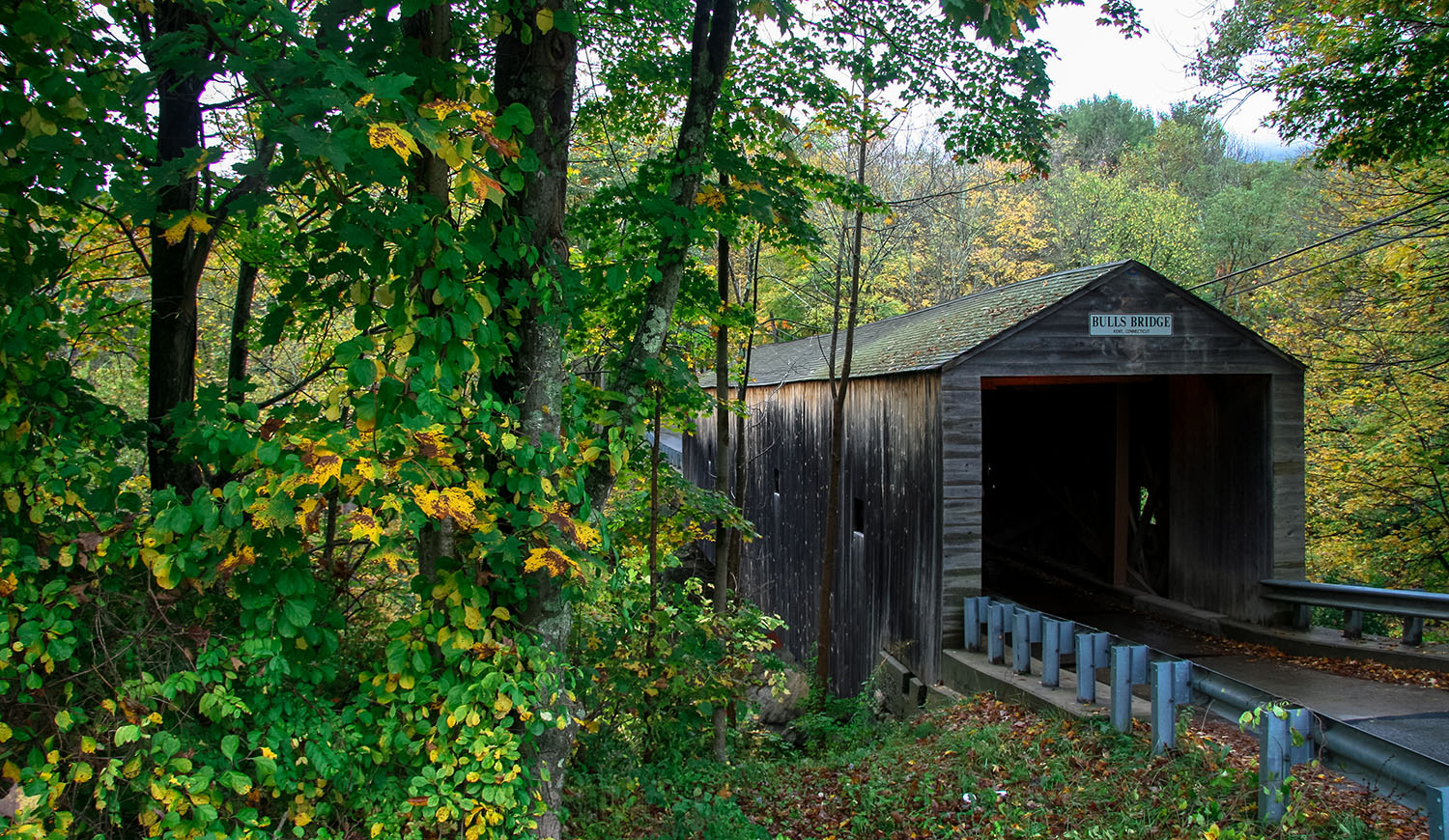
23 Jul The Bridges of Litchfield County

The West Cornwall Covered Bridge (also known as Hart Bridge), built around 1864 over the Housatonic River.
The Bridges of Litchfield County
by Leslie Battis
When I was in elementary school, we lived in Salisbury and often went fishing and exploring in the Housatonic River near the covered bridge in West Cornwall. I remember my father driving very slowly through the bridge so we could yell out the window and see if it echoed. Looking back, I’m pretty sure the people living near the bridge were annoyed by our loud antics. Or maybe they were used to them. A covered bridge has been at that location since 1762, but floods and ice jams destroyed those earlier bridges. In 1864, the current bridge was built higher above the river than its predecessors, according to Old Covered Bridges (Adelbert Jakeman, 1935).
Jakeman’s book is one of several books about covered bridges in the library collection. Originally, 18 covered bridges spanned the Housatonic River. Jakeman lists only three bridges still in use in 1935: West Cornwall, Kent (Bull’s Bridge), and Cornwall Bridge. The covered bridge at Cornwall Bridge washed away a year after Jakeman’s book was published. Tradition holds that General George Washington crossed that bridge in 1780 when he made a secret journey from New York to Hartford to meet with the patriots’ new allies – the French. Washington met Rochambeau in Hartford in September of 1780, so it is possible that he used the covered bridge at Cornwall Bridge. However, there is no written account to substantiate the claim.
There are written accounts to support that Washington crossed the Housatonic River on Bull’s Bridge in 1781. According to Covered Bridges of the Northeast, written by Richard Sanders Allen in 1957, the first instance of a bridge at this location was constructed by Jacob and Isaac Bull in 1760. The bridge was used to transport the products of Bull’s iron furnace. During the Revolutionary War, the bridge was used to get supplies to the Continental Army in Newburgh and the Hudson Highlands. In early 1781, Jacob Bull started a new bridge to replace one that washed away. The bridge was still an uncovered span when he led General Washington’s horse across while the General followed on foot. The horse fell in the river. General Washington billed the army for removal of a horse from the water at Mr. Bull’s bridge. Good thing he wasn’t riding the horse!
By 1985, when Covered Bridges of Connecticut was written by Andrew R. Howard, Bull’s Bridge and West Cornwall Bridge were still in use. Both are on the National Register of Historic Places. Bull’s Bridge was rebuilt in 1842 with a Town lattice design that was patented by Ithiel Town, a Connecticut architect. West Cornwall Bridge also used a Town Lattice design when it was rebuilt in 1864. A Queen Truss was added in 1887 for additional support.
The iconic West Cornwall Bridge has been in continuous use since 1864, having survived high water, ice jams, the 1938 hurricane, and the flood of 1955. Over a century later, the State of Connecticut considered replacing the covered bridge with a modern bridge. A local committee in West Cornwall convinced the state to renovate the bridge instead. In 1973, the bridge was raised an additional two feet above the river and the floor was reinforced with a concealed steel deck. This project won the Federal Highway Administration’s award for outstanding historic preservation. The award states that “No effort should be spared to assure its preservation for the indefinite future, especially as it is not simply a museum piece.” Let’s hope that both covered bridges continue to be valued by their communities and by kids who hope to hear an echo.

Bull’s Bridge crossing the Housatonic River in Kent, CT.




Sorry, the comment form is closed at this time.